A Laboratory Quality Management System (LQMS) refers to a set of policies, procedures, and practices implemented in a laboratory to ensure consistent quality and accuracy in its operations.
Various standards and regulations outline specific requirements for implementing a Quality Management System (QMS) in a laboratory environment, such as ISO 15189:2022, ISO 17025:2017, and FDA 42 CFR Part 493.
These standards provide guidelines and criteria for laboratory processes, including testing, calibration, documentation, personnel competency, and overall quality control.
This article will discuss the applicable standards and legislation, the 12 essential elements of laboratory QMS, and the role of QMS software in a laboratory environment.
SimplerQMS provides QMS software solutions tailored for Life Science companies, including clinical and medical laboratories. Book a personalized demo to learn how SimplerQMS can streamline your lab’s quality management processes.
In this article, we will discuss:
- What Is Laboratory Quality Management System?
- Applicable Laboratory QMS Requirements
- 12 Elements of Laboratory Quality Management System (QMS)
- Role of Laboratory Quality Management Software
What Is Laboratory Quality Management System?
A Laboratory Quality Management System (LQMS) is a comprehensive framework of processes, procedures, and practices implemented within a laboratory to ensure overall quality.
It involves systematic planning, control, and monitoring of all activities within the laboratory to comply with regulatory requirements, maintain reliable results, and enhance customer satisfaction.
Laboratory processes that require quality practices include:
- Sample handling and management
- Equipment calibration and maintenance
- Method validation and verification
- Quality control and quality assurance
- Training and competency assessment
- Document control and recordkeeping
- Customer communication and satisfaction
- And more
It is important to distinguish between the Quality Management System (QMS) in the medical laboratory and an Electronic Quality Management System (eQMS).
The laboratory QMS primarily concentrates on overseeing and ensuring quality within the laboratory’s operations. It encompasses processes, procedures, and protocols designed to maintain uniform and high quality and accuracy in testing, analysis, and reporting.
On the other hand, an eQMS offers a digital solution for effectively implementing and managing QMS principles and processes in an electronic format. It serves as a specialized software designed to align with regulatory requirements and streamline the implementation of QMS principles.
In a medical laboratory, an eQMS supports the laboratory quality management system processes such as document management, change control, CAPA management, employee training, and more.
SimplerQMS provides a comprehensive eQMS solution that encompasses all of the features and modules designed to streamline the efficiency of laboratory operations. These modules integrate seamlessly with the overall QMS framework, improving operational efficiency and supporting compliance with regulatory requirements.
Applicable Laboratory QMS Requirements
Various applicable standards and regulations govern laboratory quality management. These ensure that laboratories adhere to specific requirements and maintain a high and uniform level of quality in their processes.
NOTE
This section will discuss some requirements applicable to QMS in the laboratory, but this is not an exhaustive list. Please always refer to standards and legislation for official information.
ISO 9001:2015
The ISO 9001:2015 standard is a general requirement for a quality management system.
Although not tailored specifically for medical and clinical laboratories, ISO 9001:2015 requirements can still be followed by these laboratories to consistently deliver products and services that meet customers’ expectations and comply with regulatory requirements.
ISO/IEC 17025:2017
The ISO 17025:2017 standard establishes the requirements for testing and calibration laboratories to demonstrate their competency in testing and equipment calibration.
Compliance with this standard indicates that a laboratory possesses the necessary knowledge, skills, and resources to produce reliable and valid results.
It ensures that testing and calibration activities are conducted with impartiality, competence, and consistent operational practices. This way, laboratories can enhance their credibility, inspire confidence in their clients, and demonstrate their commitment to quality and accuracy.
ISO 15189:2022
The ISO 15189:2012 provides laboratories with a framework to develop robust lab quality management systems and assess their own competence.
This standard aims to promote the welfare of patients and the satisfaction of laboratory users through confidence in the quality and competence of medical laboratories.
ISO 15189:2012 covers a wide range of requirements, including but not limited to:
- Quality Manual
- Personnel training
- Equipment calibration
- Nonconformances
- Complaints
- Data retrieval and storage
- Environmental conditions
- Examination processes
- Risk management
- Control of records
- Management reviews
Learn more about this standard in our detailed introduction to ISO 15189:2022 article. In it, we discuss this standard’s purpose, requirements, and all aspects to provide a comprehensive understanding.
ISO/IEC 17043:2010
The ISO 17043:2010 standard focuses on proficiency testing and sets forth the requirements for laboratories to participate in interlaboratory comparisons.
Laboratories can test identical or similar samples under predetermined conditions, allowing them to evaluate their performance, identify areas for improvement, and demonstrate their competence in delivering accurate and reliable results.
CLSI HS01-A2
The Clinical and Laboratory Standards Institute (CLSI) HS01-A2 guideline specifies the requirements for a QMS model for healthcare organizations.
It offers essential background information and infrastructure to establish a quality management system aligned with healthcare quality objectives.
Implementing this guideline, along with other relevant CLSI documents, allows Life Science companies to apply the model to their unique processes.
CLSI GP26-A3
The CLSI GP26-A3 guideline outlines the requirements for applying a QMS model for laboratory services.
It is a useful resource for improving clinical laboratory processes, workflow, and operations, meeting government and accreditation requirements.
Combined with the CLSI HS01-A2, it provides a comprehensive framework for laboratories to implement a complete quality management system.
WHO Laboratory QMS Handbook
The World Health Organization (WHO) laboratory QMS handbook is a comprehensive reference on quality management systems in medical and clinical laboratories.
This handbook is based on the ISO 15189:2022 and CLSI GP26-A3 documents. It covers crucial topics necessary for effective quality management in public health or clinical laboratories.
The LQMS handbook supports the needs of management, administration, and bench-work laboratorians by offering a framework, valuable insights, and guidance to fulfill their roles and responsibilities effectively.
FDA 21 CFR Part 58
The 21 CFR Part 58 establishes Good Laboratory Practices (GLP) for nonclinical laboratories involved in research related to food and color additives, animal food additives, human and animal drugs, human medical devices, biological products, and electronic products.
Compliance with this part is intended to assure the quality and integrity of the products and substances’ safety data.
Clinical Laboratory Improvement Amendments (CLIA)
The CLIA refers to a series of adjustments made to the Public Health Services Act by the US Congress over time.
These amendments have been implemented to safeguard the accuracy and reliability of testing conducted in laboratories that perform testing on humans.
CLIA requirements are listed in 42 CFR Part 493, as listed below.
FDA 42 CFR Part 493
The 42 CFR Part 493 is designed to ensure that medical and clinical laboratories that perform testing on humans operate safely and efficiently and produce accurate and reliable results.
It requires laboratories to have a comprehensive quality management system that includes policies and procedures for all aspects of laboratory operations.
Among the requirements outlined in this part of the regulation are:
- Sample control procedures
- Complaint investigations
- Quality control and quality assurance
- Proficiency testing
- Personnel competency
- Equipment calibration
- Corrective and preventive actions
- Test reporting
- And more
12 Elements of Laboratory Quality Management System (QMS)
The 12 elements of a laboratory quality management system are the building blocks for a QMS framework in medical and clinical laboratories.
Developed by the Clinical and Laboratory Standards Institute (CLSI), these quality elements are integral to laboratory QMS effectiveness.
Neglecting any of these elements can compromise the success of the LQMS. Possibly leading to potential failures in achieving accurate and reliable laboratory results, maintaining regulatory compliance, and meeting customer expectations.
The quality system essentials are illustrated in the diagram below.
The following are the 12 essential elements of a laboratory quality management system, along with examples of how an eQMS, like SimplerQMS, streamlines these processes.
Organization
The organization refers to the laboratory’s management and the supporting organizational structure that facilitates the implementation of quality management practices.
Management must actively support the laboratory QMS and emphasize its significance to the personnel. The management must also ensure the laboratory possesses legal approval from regulatory authorities for its design and operations.
The key organizational requirements for a successful quality system are listed below:
- Leadership: Lab leaders must demonstrate commitment, vision, team-building skills, effective communication, and responsible resource management.
- Organizational structure: The organizational structure should be well-defined, with a clear organizational chart and assigned responsibilities.
- Planning process: Lab managers should have skills for effective planning, including defining timeframes, allocating responsibilities, managing resources, and financial planning.
- Implementation: Management personnel should address project management, resource allocation, adherence to timelines, and goal achievement.
- Monitoring: There should be processes for monitoring the quality management system, ensuring compliance with benchmarks and standards, and continuous improvement is important.
Personnel
Personnel is the most valuable resource in the laboratory. Their integrity, understanding of the importance of their work, and active participation in continuous improvement are essential for successfully implementing the quality management system.
Management is responsible for defining suitable qualifications for personnel in every laboratory position. Additionally, they must ensure that personnel receives proper training to meet education, skills, knowledge, and experience requirements.
Employees must undergo a performance evaluation to assess their competency, including policy adherence, safety compliance, communication skills, punctuality, and behavior.
The laboratory should maintain confidential employee records related to their work. In contrast, non-essential records may be stored with centralized departments like Human Resources.
SimplerQMS provides robust training management capabilities. The system automates training activities and securely stores employee records while ensuring GDPR compliance.
It streamlines the entire training process, from creating training plans and learning rules to tracking training deadlines and completion status.
Automated notifications for new training materials simplify staying up to date. Upon completion, personalized quizzes can be used to evaluate the effectiveness of the training.
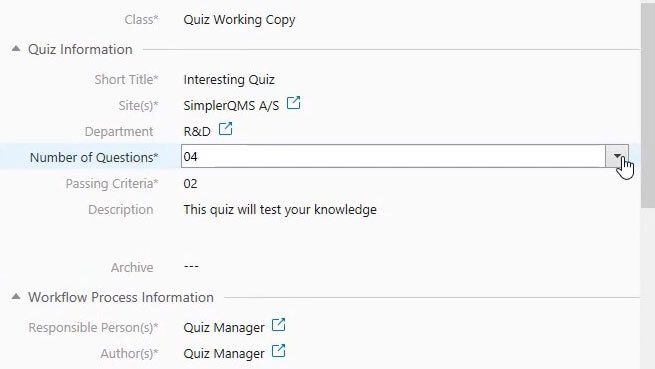
Equipment
Effective equipment management is essential to a laboratory QMS, ensuring the laboratory’s ability to conduct accurate, reliable, and timely testing.
By implementing proper equipment maintenance, calibration, and documentation protocols, laboratories can ensure the integrity of their testing processes and the optimal performance of their equipment.
When it comes to equipment management, careful planning is essential.
Several key elements should be considered in the equipment management process:
- Selection and purchasing: Laboratories should establish criteria to select equipment according to the applicable requirements.
- Installation: Requirements for installing new equipment should be followed, and specific personnel should handle the installation.
- Calibration and performance evaluation: Laboratories should perform equipment calibration and validation in new and existing instruments.
- Maintenance: Laboratories should implement maintenance plans following manufacturer guidance.
- Troubleshooting: A clear procedure should be in place for troubleshooting equipment issues.
- Service and repair: The laboratory should assess the costs involved in obtaining service and repair for its equipment. Furthermore, it should assess the availability of such facilities in its area.
- Retiring and disposing of equipment: Laboratories should have procedures for replacing old equipment and ensuring proper disposal.
A technical operator is responsible for overseeing equipment in the laboratory, ensuring proper troubleshooting and maintenance.
The laboratory must maintain a logbook with essential details about equipment, including tests performed and personnel involved.
Using SimplerQMS software, medical and clinical laboratories can streamline calibration and maintenance activities and ensure compliance with regulatory requirements.
The software streamlines equipment management tasks, such as equipment registration and qualification, making it easier for laboratories to maintain accurate information on their equipment.
It keeps track of calibration data and automatically sends notifications and reminders before calibration becomes due.
Furthermore, it allows assigning the responsibility of calibration and maintenance to appropriate personnel.
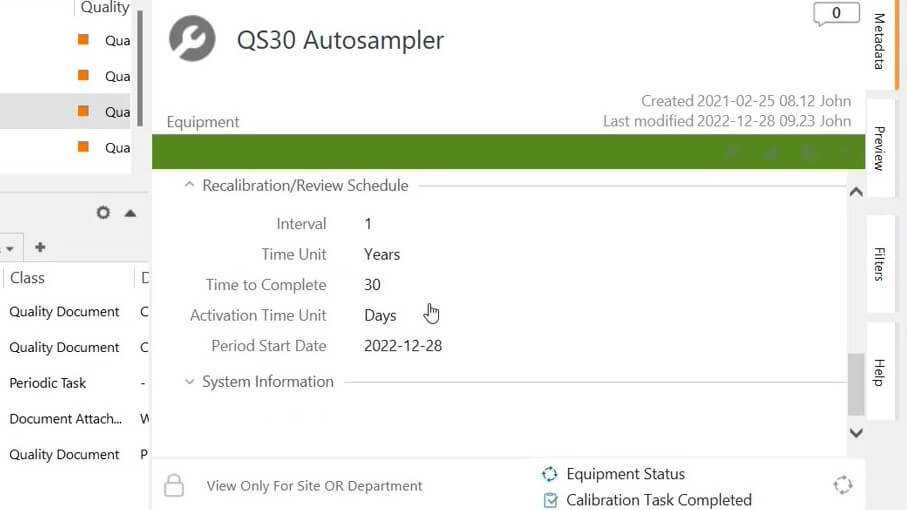
Purchasing and Inventory
Constant availability of reagents, supplies, and services is crucial for efficient and cost-effective laboratory operations. Any interruption in testing, even for a short period, can severely impact clinical care, prevention activities, and public health programs.
Establishing policies and procedures for managing critical materials and services is essential for successful purchasing and inventory management.
Some of the key components to address are:
- Supplier qualifications
- Purchase agreements
- Receiving, testing, storing, and handling materials
- Tracking materials to individual patients
- Assessing and maintaining inventory
- Controlling expiration periods
- Dispatching supplies to satellite laboratories
- And others
A successful purchasing and inventory management system in a laboratory quality management system can be achieved through the following actions:
- Assigning responsibility
- Evaluating laboratory needs
- Establishing minimum stock requirements
- Implementing electronic forms and logs
- Adopting a digital system for receiving, inspecting, and storing materials
- Maintaining an inventory system across all storage areas
For example, licensed drug manufacturers and laboratories must justify their stock levels of restricted chemicals to local drug regulatory authorities. Maintaining logs and forms ensures compliance and prevents penalties from regulatory bodies.
With SimplerQMS, laboratories can effectively manage their supplier selection process by evaluating and qualifying suppliers based on relevant performance criteria. It facilitates the maintenance of an approved supplier list (ASL) and offers templates for contracts, surveys, and supplier evaluations.
Additionally, the software sends automatic notifications and reminders for upcoming supplier certificate renewals.
SimplerQMS streamlines the entire supplier qualification process, allowing laboratories to categorize suppliers, perform qualification tasks, and conduct reviews seamlessly.
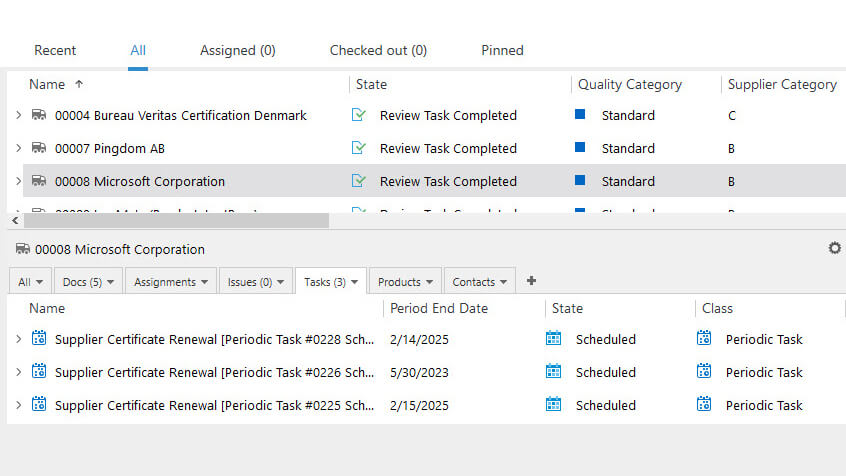
Process Control
The key factor that determines the success and performance of a laboratory is its ability to manage and control all of its processes effectively.
Sample management is essential to process control within a quality management system in laboratories.
Effective sample management is crucial for accurate and reliable testing, leading to confident laboratory diagnosis. Precise laboratory results are essential for making informed therapeutic decisions and ensuring optimal patient care and outcomes.
The sample collected must be standardized and represent the actual condition. The sample must be stored in recommended storage conditions to prevent damage as soon as it is collected.
Sample management policies must include the following:
- Information on the sample collection
- How to handle urgent requests
- Sample collection, labeling, preservation, and transport procedures
- Safety practices in case of accidents
- Methods for evaluating, processing, and tracking samples
- Storage, retention, and disposal procedures
- Among others
It is essential to manage sample documents effectively to avoid any mix-ups or discrepancies that could lead to incorrect testing outcomes. Important information such as sample identification, collection data, time, and required tests should be documented accurately.
To facilitate efficient sample management and document control, SimplerQMS has robust document management capabilities.
These features help streamline quality processes, ensuring all necessary information is recorded and accessible. By using SimplerQMS, laboratories can improve their document management practices and reduce the risk of errors or misinterpretations during testing.
Information Management
Information management is a comprehensive system encompassing all the necessary processes for efficiently managing patient data, including incoming and outgoing information.
Test results and data are the final product of laboratory operations. To ensure accessibility, accuracy, timeliness, security, confidentiality, and privacy of patient information, laboratories must establish an efficient information management system.
When developing an information management system, it is important to consider the following key elements:
- Unique identifiers for patients and samples: The same identifier should be used every time a patient utilizes the service. Similarly, a unique identifier should be generated for every sample collected.
- Standardized test request forms: Consistent forms must be used to request specific tests, ensuring clarity and accuracy in the information provided.
- Logs and worksheets: Detailed records should be maintained to track the flow of samples, test results, and any relevant observations or actions taken during the process.
- Checking processes to ensure data recording and transmission accuracy: Procedures should be in place to verify the correctness of recorded data and its proper transmission within the information management system.
- Protection against data loss: Measures such as regular backups and data recovery mechanisms must be implemented to safeguard data from loss.
- Protection of patient confidentiality and privacy: Strict protocols should be followed to maintain the confidentiality and privacy of patient information per applicable regulations and ethical considerations.
- Effective reporting systems: Systems must be established to generate comprehensive and meaningful reports based on the collected data, facilitating analysis, decision-making, and communication of results.
- Effective and timely communication: Efficient communication channels should be established to ensure a timely exchange of information among relevant laboratory personnel and patients.
SimplerQMS offers a form and template management capability that can help improve the efficiency of laboratory information management processes.
With pre-defined forms for patient information, logs, and results, laboratories can streamline data collection.
The system offers a search function to retrieve relevant documents by searching keywords in the document title and content, such as name or patient number.
Documents and Records
Document and record management is an essential component of the quality system, encompassing the utilization and maintenance.
The primary objective of maintaining QMS documentation is to ensure immediate access to information whenever required.
Documents need to be regularly updated, and an effective document control system ensures that the latest versions are accessible and in use.
Some examples of documents and reports include:
- Quality manuals
- Standard operating procedures (SOP)
- Work instructions
- Reference materials
- Sample logbook
- Patient test reports
- Incident reports
- Instrument printouts
An automated document control software solution helps ensure precise data collection by providing a streamlined and efficient process.
SimplerQMS offers Life Science eQMS with robust document control capabilities, for clinical and medical laboratories, enabling them to maintain audit-ready documents while accurately managing large volumes of data.
By utilizing the eQMS, laboratories can enhance data accuracy and reliability, improving decision-making and operational excellence.
The system facilitates easy retrieval of documents and ensures proper archiving when documents are updated.
Explore our article on laboratory document control to learn more about the importance of proper document management in ensuring accurate and reliable results.
Occurrence Management
Occurrence management is essential for maintaining quality laboratory service by effectively addressing and learning from errors. It is integral to continual improvement, focusing on identifying and managing errors or near misses.
An occurrence management program aims to correct errors in testing or communication that result from an issue and prevent their reoccurrence by improving the processes involved.
The laboratory should establish a proper system for timely investigation of all laboratory issues and errors and occurrence management, including the following:
- Establish a systematic process to detect all problems using available tools.
- Maintain a comprehensive log of problem events, documenting errors, investigation activities, and actions taken.
- Investigate and analyze the cause of identified problems, utilizing available information.
- Implement necessary corrective actions, including preventive measures, if the problem is identified before the error occurs.
- Detect and monitor any reoccurrence of the initial problem, considering potential systemic issues.
- Communicate relevant information to all stakeholders, including those affected by the error.
Occurrence management, also called incident management, is essential to every laboratory as it affects the quality of laboratory testing and results.
SimplerQMS automates the recording and tracking of nonconformances, ensuring efficient handling of identified issues.
The system also automates the notifications and reminders, ensuring that the relevant personnel is promptly informed when nonconformance tasks are assigned. This promotes accountability and facilitates timely action on identified issues.
Moreover, SimplerQMS allows you to seamlessly link nonconformances to Corrective and Preventive Action (CAPA) processes. This integration allows for the systematic resolution of issues and the implementation of preventive measures to avoid their recurrence in the future.
The software allows for comprehensive monitoring of nonconformances by product, process, customer, equipment, or supplier. Customizable views provide flexibility in analyzing and tracking nonconformances, facilitating data-driven decision-making and continuous improvement efforts.
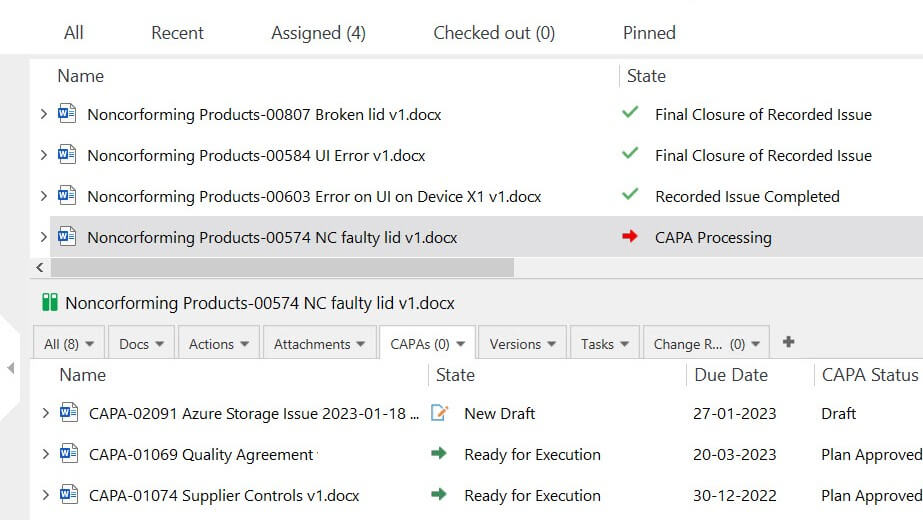
Assessment
Assessment evaluates the effectiveness of a laboratory’s quality management system through internal and external audits and performance evaluation in external quality assessment programs.
There are two types of audits: internal and external.
Internal audits are conducted by personnel within the laboratory itself. Individuals from one department assess the operations of another department. The main objective of these internal audits is to identify and address any potential weaknesses or areas of improvement.
In contrast, external professionals and experts who specialize in their respective fields conduct external audits. These audits have many purposes, such as accreditation, certification, and licensing.
The involvement of external auditors ensures impartiality and brings an objective perspective to assess the laboratory’s compliance with standards and regulations.
With SimplerQMS, laboratories can streamline the audit process, saving valuable time and effort in achieving successful audit outcomes.
The software simplifies creating audit plans, scheduling audits, assigning dedicated Issue Handlers, and attaching relevant evidence to audit findings.
It provides a closed-loop workflow by directly escalating audit findings to Corrective and Preventive Actions (CAPAs), ensuring that issues are promptly addressed and resolved.
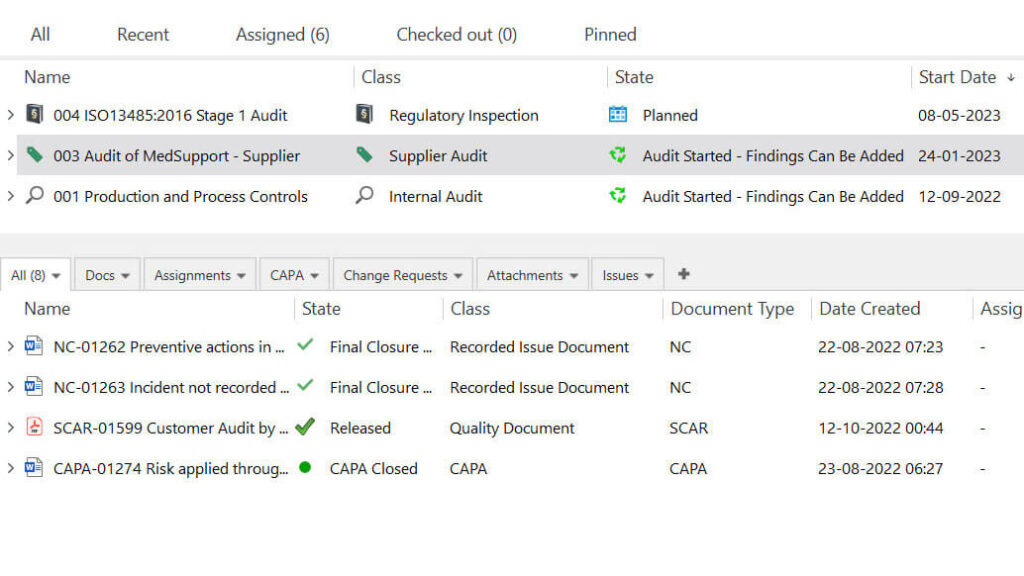
To learn more, you can explore our article on laboratory audits which provides an overview of this topic.
Process Improvement
Process improvement is a vital component of a quality management system, as it establishes a structured program to drive continuous improvement in laboratory quality over time.
The Plan-Do-Check-Act (PDCA) cycle is a valuable tool for achieving continuous improvement in any process within quality improvement efforts.
The cycle consists of four key steps:
- Plan: Identify problems and potential weaknesses and gather relevant information to develop an improvement plan.
- Do: Implement the developed plan and put it into action.
- Check: Monitor and assess the effectiveness of the actions taken, utilizing review and audit processes. Revise the plan if necessary.
- Act: Take any required corrective actions based on the evaluation and recheck the results to ensure the effectiveness of the solution. This cycle is a continuous process, initiating further planning for ongoing improvements in the laboratory.
The ISO 15189:2022 in section 4.12 specifies a comparable set of activities for achieving continuous improvement within the laboratory. These are outlined as follows:
- Identify potential sources of system weaknesses or errors
- Develop improvement plans
- Implement the plan
- Review the effectiveness of actions through focused review and audit
- Adjust the action plan and modify the system based on review and audit results.
Processes like internal and external audits, external quality assessments, and management reviews are used to identify opportunities for improvement and can serve as the basis for Corrective and Preventive Action (CAPA).
CAPA offers a systematic approach to tracking corrective actions and their effectiveness. However, manually handling CAPA processes can lead to delays and incomplete actions. Implementing an automated CAPA system can significantly improve this process.
SimplerQMS offers a comprehensive CAPA management software solution that simplifies and automates the corrective and preventive action process. Laboratories can streamline CAPA activities such as data collection, routing, notifications, approvals, and follow-up, ensuring efficient and effective management of quality issues.
The software provides a centralized platform to track CAPAs, monitor progress, and generate insightful reports, helping laboratories drive continuous improvement and achieve regulatory compliance.
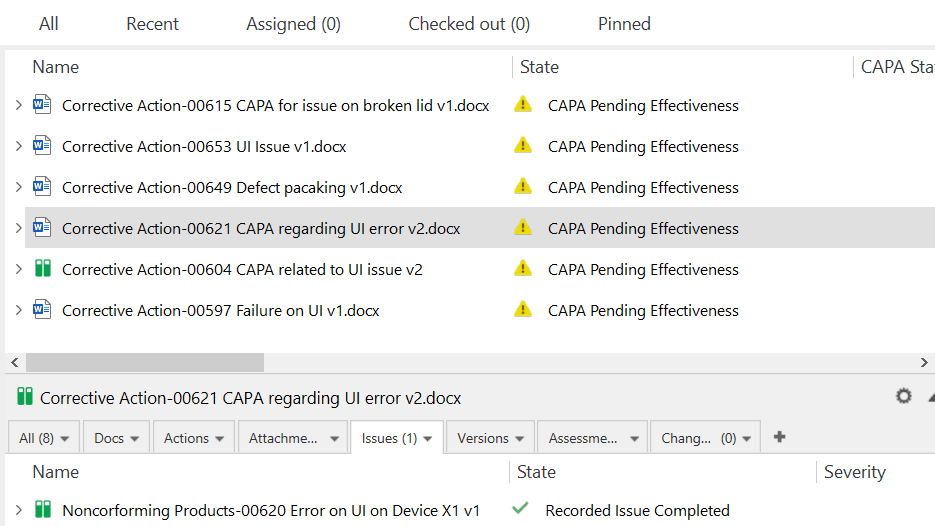
Customer Service
Customer satisfaction is a major aspect of a quality management system. The primary objective of a medical laboratory is to provide quality test results to its customers, making it essential to ensure their satisfaction.
To achieve this, the laboratory should clearly understand its clients, including patients, physicians, public health agencies, and the community. Additionally, the laboratory should remain attentive to customers’ needs and requirements.
The laboratory quality manager is accountable for measuring customer satisfaction through surveys, indicators, and audits. They are also responsible for taking proactive measures to prevent and correct any issues identified during the assessment process.
Implementing customer feedback systems enables the collection of real-time data on customer satisfaction levels.
Customer complaints are a common form of customer feedback.
With SimplerQMS’s complaint management solution, laboratories can efficiently track, manage, analyze, and resolve complaints within a single system.
It offers the convenience of storing all related documents in a cloud-based platform, enabling seamless access from anywhere.
The software automatically sends notifications to the appropriate personnel, ensuring prompt attention to customer feedback. It provides valuable insights into feedback data, enabling effective utilization for product improvement and increasing customer satisfaction.
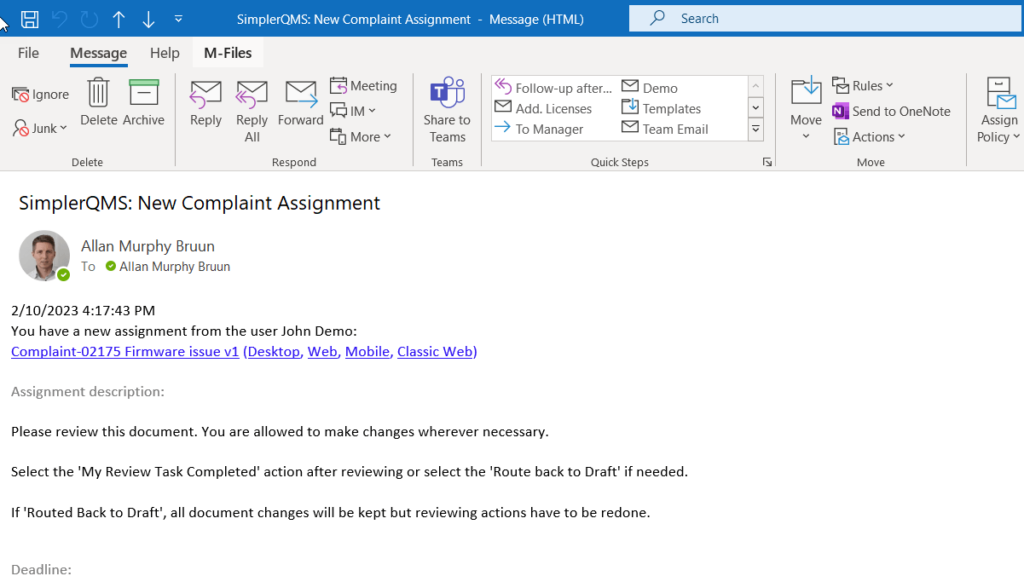
Facilities and Safety
The laboratory workspace and facilities should be designed to accommodate the workload while ensuring the quality of work and the safety of laboratory personnel.
Neglecting laboratory safety can result in significant costs and adverse consequences, such as:
- Loss of reputation
- Loss of customers
- Low staff retention
- Increased costs related to human resources.
The laboratory manager is responsible for both safety and quality in the laboratory. This includes actively participating in lab design, assessing potential risks, and providing valuable feedback to ensure the development of a safe laboratory environment.
Risk assessment is essential for the laboratory to manage and minimize risks to employees effectively. Developing clear safety procedures for handling accidents, injuries, and contamination is vital.
SimplerQMS can help laboratories identify and assess potential risks associated with processes, equipment, personnel, and patient safety.
SimplerQMS Risk Management module allows laboratories to develop risk mitigation plans by defining appropriate control measures, implementing preventive actions, and establishing contingency plans.
The software enables documenting risk mitigation strategies and assigning responsibilities to ensure effective implementation.
Role of Laboratory Quality Management Software
The purpose of laboratory quality management software is to streamline and improve quality processes within laboratories. This specialized software is a comprehensive solution that allows companies to manage and streamline laboratory operations, ensuring compliance with regulatory standards and industry best practices.
The software supports the 12 essential elements of the quality management system in medical laboratories by providing a unified platform for efficiently managing documents, equipment, personnel, processes, testing activities, and other processes.
While eQMS for laboratories offers significant advantages, it is important to consider that a manual and hybrid approach may still be suitable for some companies, especially those with limited resources or specific operational requirements.
The decision to adopt QMS software should consider the laboratory’s specific needs, resources, and regulatory requirements.
SimplerQMS is specifically designed for Life Sciences, including medical and clinical laboratories. It provides robust support for compliance with several Life Science requirements.
With its interconnected QMS modules, SimplerQMS offers key functionalities that align with the 12 essential elements of a laboratory quality management system. These modules include document management, employee training, nonconformance management, CAPA management, audit management, risk management, and more.
SimplerQMS is a fully validated solution, validated according to ISPE GAMP5 guidelines.
This means that all software validation processes are handled by SimplerQMS, eliminating the need for customers to allocate additional resources, time, or costs for software validation.
Additionally, SimplerQMS provides pre-configured workflows, templates, and ongoing support to facilitate a smooth implementation and utilization of the software. This helps laboratories manage their quality management system efficiently, achieve compliance, and drive continuous improvement.
To better understand the benefits of implementing an eQMS solution, we suggest downloading our eQMS Business Case template.
This valuable tool provides a structured approach for assessing the value of an eQMS tailored to your company’s needs, facilitating effective communication of your findings to management.
Using a business case analysis, you can uncover potential ROI, cost savings, efficiency increase, and compliance improvements, including compliance with standards and regulations.
Final Thoughts
Laboratory QMS software streamlines quality processes in laboratories, helping ensure compliance with standards and regulations.
It facilitates effective quality management in medical laboratories by supporting the 12 essential elements of quality management systems.
Implementing QMS software can significantly facilitate the implementation of quality processes, especially when compared to traditional paper-based and hybrid methods.
Working in a medical or clinical laboratory demands handling large amounts of data and information, including various documents, reports, and written materials. Control over these documents is crucial to maintain work quality and comply with regulatory requirements.
With robust security features, SimplerQMS allows users to work efficiently with their documentation, helping ensure compliance with Life Science requirements.
If you are interested in learning more about we encourage you to book a personalized demo and talk to SimplerQMS Quality Solution experts.